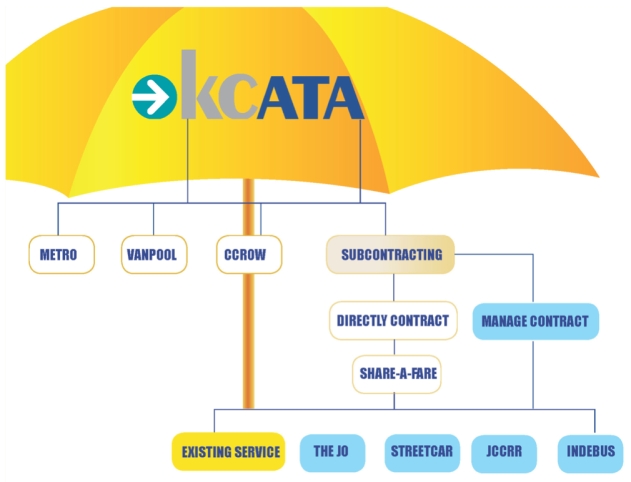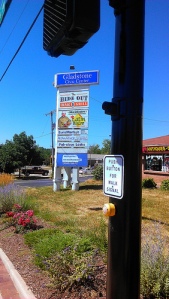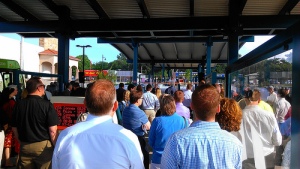 KCATA has launched an ambitious new plan to re-invent itself. Will it succeed? Will it adopt a new name in the process? Will we finally see real progress toward a unified regional transit system? Those are some of the questions that could be answered in the next couple of years.
KCATA has launched an ambitious new plan to re-invent itself. Will it succeed? Will it adopt a new name in the process? Will we finally see real progress toward a unified regional transit system? Those are some of the questions that could be answered in the next couple of years.
Robbie Makinen, Chair of the KCATA Board of Commissioners, met with TAN for an hour and a half at both our May and July meetings for in-depth discussions about the big changes being contemplated at the area’s transportation authority.
So what is really going on? When Makinen was appointed as Jackson County’s representative on the KCATA Board he discovered that KCATA had significantly more power than it was using. After all, KCATA was created by an act of the US Congress to be the transportation authority for this seven-county region. It’s charter is modeled after that of the New York Port Authority (NYPA), which gives it broad powers, including operating and/or managing all types of public transportation: buses, local rail systems, and even airports. What’s more, KCATA has broad development powers: they could even build a skyscraper.
When Independence bid out its intra-city bus routes and decided on a different transit operator in 2012, KCATA realized it was time to reconsider its regional role. “KCATA doesn’t have to operate everything,” Makinen says. He thinks KCATA keeps its extra powers in a “locked box”, and he decided it was time to open that box.
So what has been keeping KCATA from assuming a broader regional role and vision? Part of the problem lies in the fact that even though Congress gave it all the powers like the NYPA, they failed to include taxing authority. KCATA cannot act on its own to raise money like the NYPA does with taxes, fees, etc. KCATA can only provide its services under contract, and most of the government entities in the region haven’t come up with much money to purchase transit.
Why change now? The important factor driving this change is that public transit service is becoming more fragmented in our region. That not only leads to operational inefficiencies, but it also presents riders a bewildering array of inconsistent fare structures and policies, operating practices, and other barriers to riding transit. In short, a transit experience that is anything but seamless. What’s more, in many parts of the region public transit doesn’t even exist.
In addition to KCATA, the Kansas City region is currently served by Unified Government Transit (UGT), Johnson County Transit (JCT) and now the Independence Transit Service (IndeBus). In 2015, the Downtown Streetcar will be a fifth operating system. KCATA chose not to bid on operating the streetcar.
To start the KCATA visioning process, the KCATA Board of Commissioners had a strategic planning meeting the end of April to explore how to re-invent and/or re-structure in order to utilize its additional powers.
(See the board briefing paper summarizing that meeting below.)
The briefing paper outlines four priorities:
1. Stakeholder Coalition
2. Organizational Restructuring
3. Bi-State Compact Review
4. Regional Service Needs Assessment
Let’s look at each of these priorities.
1. Stakeholder Coalition. KCATA General Manager Mark Huffer made the first public presentation about the new vision at the May meeting of the KCATA Board of Commissioners. That meeting was also attended by the “KCATA Funding Review Committee” of the KCMO City Council. See Mr. Huffer’s presentation below.
Since then Makinen and Vice-Chair Steve Klika, along with other Board members and Huffer, have been speaking to elected officials, and with civic and business leaders, in order to achieve the extensive stakeholder involvement needed to make KCATA’s anticipated restructuring a success.

Possible new organizational structure for KCATA
2. Organizational restructuring. KCATA expects to have plans completed for significant restructuring by the end of this year. Bus operations would be separated from administrative and regional functions. Other units might be created to manage other transit operations, provide a wide array of transit support functions separate from direct bus operations, and initiate community and economic development projects.
As Makinen is fond of saying “There are things the ATA does in its sleep that other agencies do not want or need to do separately.” He continues that, “ATA can manage and/or operate a regional multi-modal public transportation system and I am really pleased that the Board of Commissioners has embraced this direction.“
3. Bi-State Compact review. The bi-state compact that created the KCATA in 1965-6 establishes all the powers the Authority has as well as the composition of the Board of Commissioners.
Some people think the composition of the Board of Commissioners needs to be reviewed.
Is it important to change the structure of KCATA’s governing board? Changing the composition of the KCATA Board hardly matters in the short-term, if it matters at all. KCATA can make the structural, administrative and functional changes in its new vision without making any changes to the board. What matters is that the region sees members of the board as engaged, proactive, and responsive to the needs of the community and its clients. In addition, changing the composition of the board is complicated. It requires agreement locally on a new structure, getting governors from both Kansas and Missouri to agree and then getting an Act of the US Congress to make the changes. That probably won’t happen quickly even if everyone could agree on a new structure. It would likely take two years, minimum, once local agreement is reached.
While restructuring might be discussed as a part of a broader regional engagement process, our preference is that restructuring be the last phase in the process. There are too many ways that debate over governance structure could derail other more important improvements. Instead, let’s evaluate how big an impact a reorganized ATA can have without changing its governance structure.
If a change to the composition of the board is needed down the line, so be it, but if KCATA is moving away from only being a bus operator, there isn’t clarity today on what a new structure should look like for a re-invented KCATA. Old ideas for changing governance revolved around representation based on who contracts for bus service.
If KCATA can re-make itself to truly function as the “AREA Transportation Authority,” instead of JUST a bus operator, then having a broad-based Board of Commissioners from across the region — such as provided in the current structure — may still be the best regional make-up.
4. Regional Service Needs Assessment: Under a “new” KCATA, regional needs are seen as combination of transit related activities and development activities.
A. Transit related functions:
- Current Bus Operations. KCATA would continue to manage and operate the current transit services such as The Metro, Share-A-Fare, and the Van Pool program.
- Management of Other Transit Operations. This one little item would be the biggest change to KCATA’s functions, as you will see in Huffer’s presentation, under a revamped KCATA umbrella organization. This change would require KCATA to reorganize internally to ensure that its current transit operations are separate from a new function of managing rather than operating transit.
- Downtown Streetcar. The Kansas City Streetcar Authority (KCSA) is responsible for selecting an operator and setting operating policies for the Downtown Streetcar line. There are questions about their ongoing role once the streetcars are operating, and it’s quite possible they will fade away and turn over management to another entity such as KCATA.
- Commuter Rail. If Jackson County establishes a commuter rail system, they might contract with a private company to operate that rail system. KCATA might fulfill the management role.
- Smart Moves. KCATA might take the lead in implementing the Smart Moves regional transit concept created by MARC over a decade ago. Most of the concept has never been implemented since there isn’t an implementing body for the whole plan. KCATA could play a role in ensuring that these services are operated in an integrated, coordinated manner.
- Transit Coordinating Council. KCATA is slated to co-chair the new Transit Coordinating Council. MARC and KCATA are jointly creating this new council, which will work to bring the various transit agencies together to work for a more seamless regional transit system.
- Economies of Scale. KCATA would coordinate regional activities to leverage economies of scale and improve efficiencies for all the transit agencies. Examples from Huffer’s presentation: Fuel Purchasing, Vehicle Procurement, Grant Writing, Planning, Marketing, and Paratransit Services
- Expanded transit support operations: KCATA already operates the Regional Call Center, and provides some limited support services, primarily for The JO. These services could be expanded to include maintenance of on-street transit facilities such as bus stops and shelters, scheduling and dispatching systems, purchasing, etc.
- Administrative functions for others. KCATA is already assisting KCMO and KCSA in administrative matters related to federal grants for the streetcar, and it helped the Streetcar Authority put together the RFP (request for proposals) to find an operator. KCATA could broaden its efforts in grant administration and contract management.
B. Development Activities
- Community and Economic Development Chairman Makinen has been very outspoken about KCATA expansion into these realms, “We need to re-think the role of the KCATA. It has a major role in helping the region be successful and create seamless transit. But we also need to change the mindset and perception of the ATA. Cities and the region should look to the ATA for both Community Development and Economic Development opportunities as well as transit coordination and services.” Makinen’s example of using the ATA to improve the community is the Early Development Learning Center combined with the Metro Center at 39th and Troost. For economic development he reminds us that KCATA applied for and received about $24 million from the FTA toward renovation of Union Station, and some $12 million or so of that was used to construct “The Link,” which connects Union Station with Crown Center. “These examples barely tap ATA’s potential for community and economic development projects,” he says.
- TOD Transit Oriented Development is often cited as a goal with transit projects, but like Smart Moves, unless some group is designated to make it happen, it usually doesn’t. MARC is a planning agency and doesn’t engage in implementation. Los Angeles and Portland have significant TOD because their transit authorities have dedicated departments to make that happen. If this region really wants new development that is designed to support and capitalize on transit, then KCATA could be the agency that makes that happen.
Finally, KCATA is considering renaming or re-branding itself. MTA – Metropolitan Transit Authority? RTD – Regional Transit District? Something with a more distinctive regional flavor? It’s very much open to discussion.
These are all big ideas and big potential changes for KCATA. Some of these changes will be easier to implement than others. The Amalgamated Transit Union, for example, has expressed concern about KCATA branching out to manage transit operators that don’t include ATU members.
So there are opportunities and challenges ahead. KCATA plans to use more of its existing powers to build an integrated seamless transit service in the Kansas City region, along with great community and economic development projects.
Stay tuned for big changes at the KCATA.
BOARD BRIEFING PAPER strategic planning
Huffer’s presentation at BOC KCATA BOC Visioning Process
 KC needs your ideas on how to move forward with Phase 2, an expansion of the streetcar system.
KC needs your ideas on how to move forward with Phase 2, an expansion of the streetcar system.




















